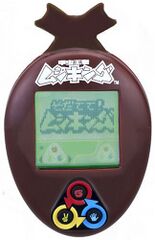Sodatete! Kouchuu Ouja Mushiking
From Sega Retro
| This article needs cleanup. This article needs to be edited to conform to a higher standard of article quality. After the article has been cleaned up, you may remove this message. For help, see the How to Edit a Page article. Further information: The releases section needs merging into the Bob's releases field, which requires updating Template:ReleasesLCD to the current standard, while the packaging images need to go into a Physical Scans section. Please see the talk page for more information. |

| ||||||||||
| Sodatete! Kouchuu Ouja Mushiking | ||||||||||
|---|---|---|---|---|---|---|---|---|---|---|
| System(s): LCD | ||||||||||
| Publisher: Sega | ||||||||||
| Peripherals supported: Neck strap | ||||||||||
| Genre: Simulation | ||||||||||
| Number of players: 1[1] | ||||||||||
| Official in-game languages: | ||||||||||
|
Sodatete! Kouchuu Ouja Mushiking (そだてて!甲虫王者ムシキング[2]), shortened to Sodatete! Mushiking (そだてて!ムシキング) on the packaging and devices, is a set of handheld LCD digital pet games based on the Kouchuu Ouja Mushiking franchise. Two models were produced in the set, with both models containing the same game.
Contents
Gameplay
Sodatete! Mushiking has the player raise and train a pet beetle, referred to as "Mushi", akin to other LCD digital pet games like the Tamagotchi and Digimon line of handheld games. The player starts with an egg that hatches into a larva, which then grows into a type of beetle that they must name and care for. Basic care features are included, such as feeding the Mushi on a regular basis, and treating its injuries and illnesses when the need arises and cleaning up spoiled food. The Mushi will periodically sleep, and will adjust its schedule depending on when the player wakes it.
In addition to feeding and nurturing the Mushi, the player will also train the Mushi for battle in timing-based training regimens, and can then battle other Mushi. The battle mechanics are largely the same as other games in the Mushiking franchise in that the player utilises Rock-Paper-Scissors-based mechanics to outwit and defeat opponents. Two players can connect their devices together wirelessly using the infrared sensors to have their Mushi fight each other.
After some time, the player will inevitably lose their Mushi to various factors. If the player does not tend to the Mushi's hunger or illness, it will die. If properly cared for throughout its lifespan (about 6-10 days), the Mushi will fly away, leaving behind an egg that inherits the parent's traits. Sometimes a Mushi will suddenly go missing - if it is not recovered soon, it will be lost forever.
History
Development
The Sodatete! Kouchuu Ouja Mushiking LCD games were designed by Masahiro Sakurai, famous for creating the Kirby and Super Smash Bros. series. Sakurai's involvement with project started when he was approached by then-Sega executive Tadashi Takezaki, requesting the idea of crossing the Mushiking franchise with handheld digital pet games. Thus, Sakurai wrote a proposal during Golden Week in the form of a PowerPoint presentation on May 9, 2005, explaining how the games' mechanics would work. The general idea of the games in the final product stayed more or less the same as the proposal[3].
A small team was assembled to design the LCD game, with Kan Naito of Dragon Quest III and IV fame handling the programming. The development team took into consideration how different growth stages in digital pet games will be stronger or weaker than others, and took care not to let players run into a wall in battles. Various other features, such as having the Mushi graze on its meals instead of consuming it instantly, were added to give players a stronger sense of raising their pet. The development board for the LCD games was a regular piece of wood just under one square metre with circuit boards attached on top[3].
At E3 2005, shortly after making the proposal, Sakurai was approached by Nintendo to make Super Smash Bros. Brawl. This resulted in the development of both games overlapping with one another, with Sakurai often having to hide the development board when he needed to work on Brawl. At the time, Sakurai worked remotely, and only had a few in-person meetings alongside key staff at Sega headquarters. Outside of those, development was accomplished through email and online communication[3].
As a result of the work management, Sakurai was never able to test the game on a production handheld before it was done. This led to the LCD games being shipped with a bug in that the Mushi would become hungry at a faster rate than intended, likely due to differences in processing speeds[3].
Sakurai's proposal document shows that six different model designs were proposed, but only two designs, Kabuto Mushi and Nokogiri Kuwagata, entered production. The LCD games were also proposed to be able to dock into a Card Base peripheral, allowing the user to scan their Mushiking cards to acquire new skills and food for their Mushi, though this feature was not implemented into the final game. Other features, such as aerial battles and food wars, never made it into the final product[3].
Releases
| Code | Name | Box scans | Images | Region | Date | Price | Documentation | Description |
|---|---|---|---|---|---|---|---|---|
| HCV-0701 | Kabuto Mushi (カブトムシ) |
|
2006-02-23[1] | ¥2,667 (2,800)¥2,667 (2,800)[1] | ||||
| HCV-0702 | Kabuto Mushi (カブトムシ) |
|
2006-02-23[1] | ¥2,667 (2,800)¥2,667 (2,800)[1] | ||||
| HCV-0703 | Nokogiri Kuwagata (ノコギリクワガタ) |
|
2006-02-23[1] | ¥2,667 (2,800)¥2,667 (2,800)[1] | ||||
| HCV-0704 | Nokogiri Kuwagata (ノコギリクワガタ) |
|
2006-02-23[1] | ¥2,667 (2,800)¥2,667 (2,800)[1] | ||||
| HCV-0705 |
|
|||||||
| HCV-0706 |
|
|||||||
| HCV-0707 |
|
|||||||
| Neck Strap Kabuto Mushi (ネックストラップ カブトムシ) |
|
2006-02-23[1] | ¥680 (714)¥680 (714)[1] | Neck strap accessory | ||||
| Neck Strap Nokogiri Kuwagata (ネックストラップ ノコギリクワガタ) |
|
2006-02-23[1] | ¥680 (714)¥680 (714)[1] | Neck strap accessory |



